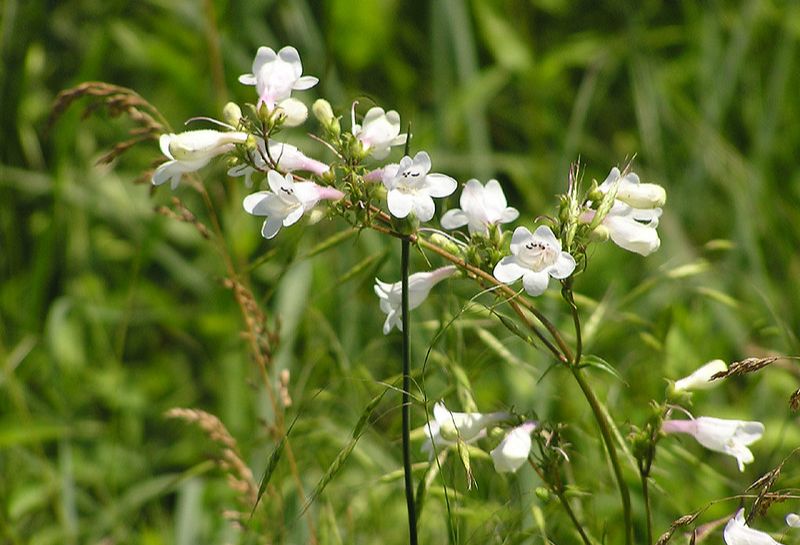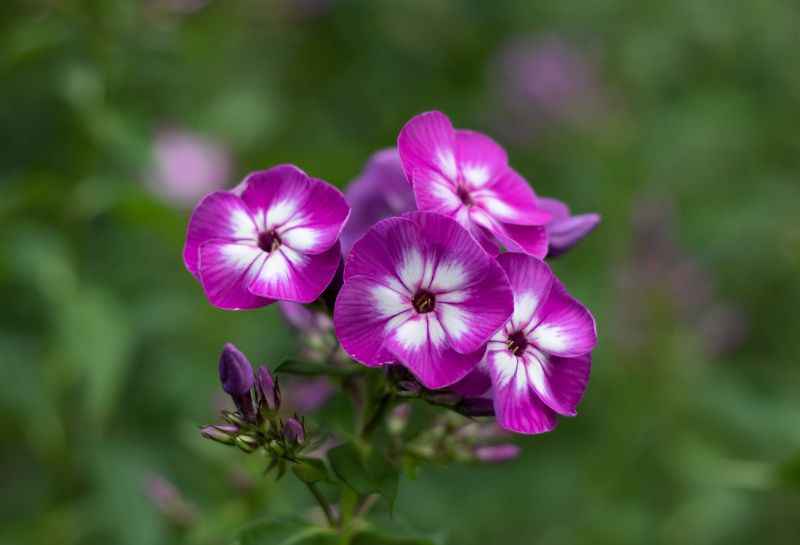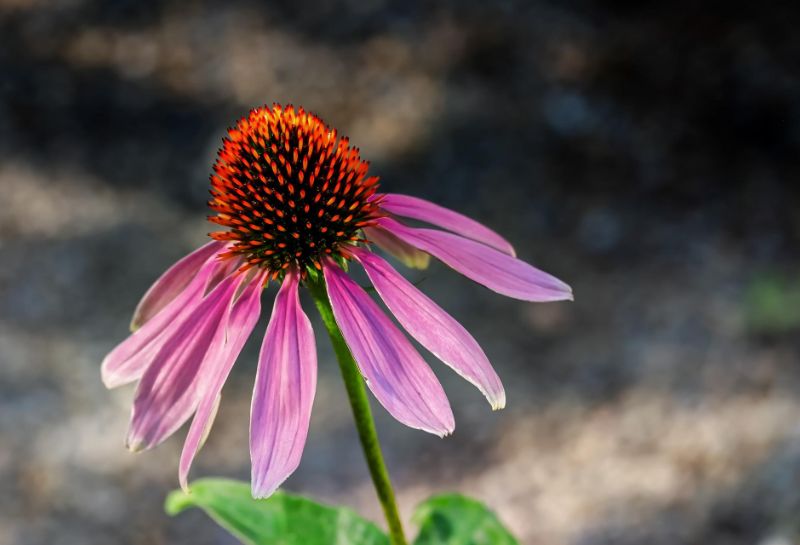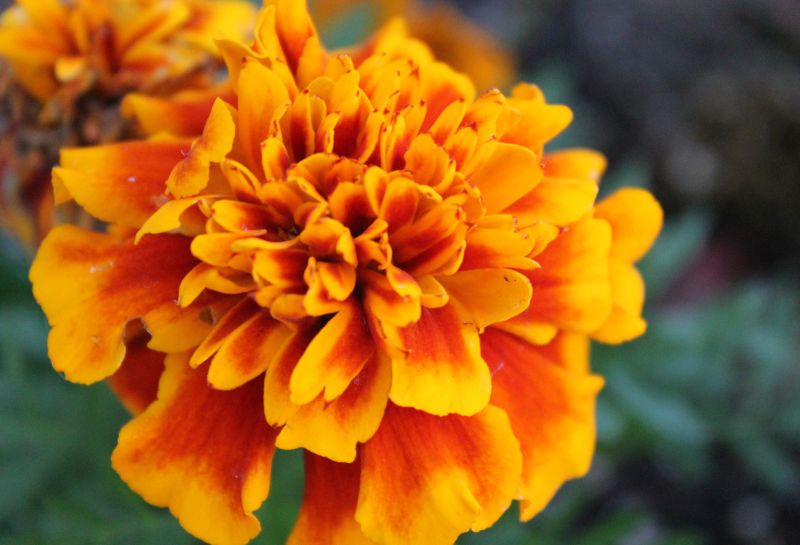
The gift of a beautiful bouquet of flowers can celebrate an achievement, make someone feel loved, or simply brighten an ordinary day. Take your flower arrangements to the next level by snipping them from your very own cutting garden filled with plants that will bring cheer to your backyard, kitchen, and sweetheart.
We’ve curated a list of easy-to-grow flowers with vibrant blooms. There’s a mix of native and nonnative species along with different bloom times so you can have fresh flowers on your table year-round.
Our top picks for best 14 flowers for a cutting garden:
- Common sunflower
- New England aster
- Sage
- Zinnia
- Foxglove beardtongue
- Daffodils
- Yarrow
- Garden phlox
- Tulips
- Peonies
- Pincushion
- Sweet pea
- Purple coneflower
- Marigold
Once you’ve chosen your flowers, check out our guide to planning and growing your cutting garden.

1. Common sunflower (Helianthus annuus)
No flower garden is complete without the iconic sunflower. Native to North America, the sunflower is a famous symbol for cheer and good spirits. Its golden rays are sure to lighten the mood in your kitchen, and the showy stalks will delight the neighbors.
With enough sun and good drainage, your sunflower will thrive. If you get coastal or storm winds, choose an area shielded from powerful gusts to avoid knocking down your sunflowers. You can hold up sunflowers with bamboo stakes or plant them alongside a fence (I’m sure the kids next door won’t mind a few blooms peeking over).
Plant origin: Native
Hardiness zones: 4-9
Sun: Full sun
Water needs: Moderate
Soil: Dry, sandy
Duration: Annual
Mature height: 6-12 feet
Bloom time: Late summer

2. New England aster (Symphyotrichum novae-angliae)
The New England aster crops up almost everywhere east of the Rocky Mountains. Coming in shades of dark purple, pink, and red, this is a great choice for a gardener who wants a low-maintenance flower with a bright payoff. The daisy-like shape features an abundance of thin, radial petals spreading from a yellow center. It’s a favorite among pollinators, especially because it’s a late-season nectar source.
Caring for the New England aster is straightforward. It prefers moist soil, but can tolerate short periods of drought. Planting the flower in full sun from all directions will reduce the likelihood of it flopping over. Finally, if any blooms remain after cutting, be sure to remove them once they fade to prevent the plant from spreading.
Plant origin: Native
Hardiness zones: 4-8
Sun: Full sun
Water needs: Medium
Soil: Moist, rich
Duration: Perennial
Mature height: 3-6 feet
Bloom time: Late summer to early fall

3. Sage (Salvia)
Salvias include much more than just your common kitchen sage. This group of flowers provides bright summer blooms. Colorful, densely-packed flowers gather along an upright, long stem, adding spikes of vibrant hues to your garden bed. There are many types of salvia, some native and some not. Salvia farinacea is a great native option with bluish-purple flowers, while salvia coccinea is a crimson native variety.
Once established, salvia is relatively drought tolerant, but is more attractive with occasional watering. If your plant flops, it may mean it’s getting too much water, not enough sun, or that it’s time to prune or divide. Use salvia as a border plant; its strong scent deters deer and rabbits. Give them space based on their estimated mature size so they’re not too crowded.
Plant origin: Native
Hardiness zones: 5-10
Sun: Full sun to partial shade
Water needs: Low to moderate
Soil: Moist, well-draining
Duration: Perennial
Mature height: 1-3 feet
Bloom time: Late spring to fall

4. Zinnias (Zinnia elegans)
Zinnias feature layers of petals forming a dome shape that looks a little like the honeycomb paper lanterns you hang at a birthday party. You might mistake them for dahlias, but zinnias have smaller flowers and are hardier overall. They’re known for their bright colors, quick growth, and large, profuse blooms. Zinnia flowers come in single, semi-double, and double varieties (referring to the number of rows of petals), as well as a full spectrum of colors.
Native to Mexico and Central America, zinnias prefer a warmer climate. In Zone 8 or below, they’re grown as annuals and will die off with the first hard frost. Zinnias don’t mind drought, and most likely won’t need supplemental watering.
Plant origin: Nonnative
Hardiness zones: Annuals in 2-8, perennials in 9-11
Sun: Full sun
Water needs: Low
Soil: Well-draining
Duration: Dependent on your USDA zone
Mature height: 1-4 feet
Bloom time: Early summer through fall

5. Foxglove beardtongue (Penstemon digitalis)
Looking for a native replacement for snapdragons? Foxglove beardtongue is snapdragon’s hardier cousin that will survive easily as a perennial. Dozens of tubular flowers grow upward along a stalk and come in all shades of pink, lavender, red, and white.
Full sun and well-draining soil are all this plant needs to thrive. foxglove beardtongue is a great choice for an area of your garden that has average to poor soil and for areas where you don’t receive a lot of rainfall, as beardtongue is remarkably drought tolerant. In chillier climates (below Zone 3), it will need to come inside during frosts if you want it to live as a perennial.
Plant origin: Native
Hardiness zones: 3-8
Sun: Full sun
Water needs: Low to medium
Soil: Average, dry to medium, well-draining
Duration: Perennial
Mature height: 3-5 feet
Bloom time: Mid-spring to early summer

6. Daffodils (Narcissus)
Just when you think you can’t make it through another day of winter, the first sign of spring appears: daffodils. These yellow beauties herald warmer weeks ahead and are the perfect cut flower to bring some sunshine into your home.
It’s important to pinch off daffodil blooms as soon as they fade, but leave dying foliage in place until it turns yellow. When blooming, daffodils need generous watering, but well-draining soil is key to avoiding bulb rot. With proper care, daffodils will last years in your garden.
Pro Tip: When choosing your bulbs, pick large ones that are firm to the touch and have a dry papery covering.
Plant origin: Nonnative
Hardiness zones: 4-8
Sun: Full sun
Water needs: Moderate
Soil: Well-draining, rich, moist
Duration: Perennial
Mature height: 6-30 inches
Bloom time: March and April

7. Yarrow (Achillea millefolium)
The most common type of yarrow sports flat clusters of small white flowers comparable to baby’s breath that give any arrangement a delicate touch. Yarrow is also known as plumajillo, Spanish for “little feather,” and the name accurately captures the leaves’ slotted shape and soft texture.
Yarrow prefers dry to medium soils (and will survive drought), and can do alright in poor soils with adequate drainage. Because it’s an aggressive plant (and considered an invasive weed by some), keep a light hand with the fertilizer. An annual dressing with compost will provide all the necessary nutrients.
Plant origin: Nonnative
Hardiness zones: 3-9
Sun: Full sun
Water needs: Low
Soil: Well-draining, sandy, average
Duration: Perennial
Mature height: 2-3 feet
Bloom time: Early summer to early fall

8. Garden phlox (Phlox paniculata)
For a cottage garden flower that produces delicate, colorful blossoms, look no further. Phlox comes in pink, red, purple, orange, white, and multi-colored varieties with hues ranging from pastel to deep, vibrant colors.
Garden phlox has maximum blooms in full sun, but it tolerates light shade. Give them plenty of space away from other plants, fences, and walls to improve air circulation and lower the risk of disease. Not only are phlox easy to care for, they also bloom as long as six weeks or more.
Plant origin: Native
Hardiness zones 4-8
Sun: Full sun to partial shade
Water needs: Moderate
Soil: Rich, medium moisture, well-draining
Duration: Perennial
Mature height: 2-4 feet
Bloom time: Mid to late summer

9. Tulips (Tulipa)
A cutting garden wouldn’t be complete without the tulip. The iconic spring-flowering bulb has a distinct cup shape with three petals. There’s no shortage of tulip varieties — you can find any color combination imaginable.
Although they can survive in Zones 3 through 8, tulips grow best as perennials in areas with moist, cool winters and dry, warm summers. Otherwise, you can grow them as annuals and replace the bulbs with summer flowers once blooming is complete.
Plant origin: Nonnative
Hardiness zones: 3-8
Sun: Full sun
Water needs: Moderate
Soil: Rich, moist, well-draining
Duration: Perennial or annual
Mature height: 9-24 inches
Bloom time: April to May in cold climates; February to March in warm climates

10. Peony (Paeonia lactiflora)
The common garden peony hails from Tibet. The lush, ruffled flower is unmistakable and always a showstopper. Your new peony plant may outlive you — they can survive for at least 100 years. There are two varieties native to North America (paeonia brownii and paeonia californica), but they might not be the image you have in mind.
Peonies thrive in full sun and well-draining soil. They don’t mind winter chill, either, because it helps with bud formation. Plant peonies along your walkway or anywhere you need a low hedge.
Plant origin: Nonnative
Hardiness zones: 3-8
Sun: Full sun to partial shade
Water needs: Moderate
Soil: Rich, well-draining
Duration: Perennial
Mature height: 2.5-3 feet
Bloom time: Late spring through early summer

11. Pincushion (Scabiosa atropurpurea)
Pincushion flowers will give your landscape a whimsical, English garden feel. The 2-inch wide flowers are marked by a dainty ring of lavender-blue petals. The prominent stamen extending from the center give it the name “pincushion.” Not only do these flowers add a twilight color and frill to a cut flower arrangement, they look beautiful swaying in the breeze in the garden too.
These flowers don’t require much fuss. As long as they have direct sunlight, you can expect blooms from late April until the first frost. It will suffer in wet soil, especially during the winter. If you have heavy soil, amend it with compost before planting.
Plant origin: Nonnative
Hardiness zones: 3-7
Sun: Full sun
Water needs: Moderate
Soil: Moist, well-draining
Duration: Perennial
Mature height: 12-18 inches
Bloom time: Late spring to fall

12. Sweet pea (Lathyrus odoratus)
The sweet pea flower is a longtime favorite for its profuse blooms of butterfly-like flowers. Not only do the dainty flowers add a feminine touch to your garden, you might find yourself lingering to soak in their honey and orange blossom fragrance.
Sweet pea grows as a twining vine. Plant it near a trellis, pergola, or fence to add a cottage feel to your hardscaping. Water an established sweet pea weekly. During the growing season, fertilize monthly with a fertilizer high in potassium.
Plant origin: Nonnative
Hardiness zones: 3-8
Sun: Full sun to partial shade
Water needs: Moderate
Soil: Well-draining, rich, slightly alkaline
Duration: Perennial
Mature height: 6-8 feet
Bloom time: Spring to summer

13. Purple coneflower (Echinacea purpurea)
Once established, coneflowers will persist through tough conditions and continue to give you an abundance of flowers. The pink and lavender, daisy-like blooms extend from a spiky, domed center. Keep an eye out for visitors like hummingbirds and finches who enjoy coneflower’s nectar and seeds.
Coneflower tolerates a range of soil conditions, but doesn’t enjoy being stuck in the muck (who does?). If you have a clay-heavy soil, mix a little compost in during planting to improve the drainage. You don’t necessarily need to prune coneflowers, but deadheading will keep them blooming all summer.
Plant origin: Native
Hardiness zones: 3-8
Sun: Full sun to partial shade
Water needs: Moderate
Soil: Sandy, well-draining
Duration: Perennial
Mature height: 2-5 feet
Bloom time: Summer

14. Marigold (Tagetes species)
Marigolds are the crown jewel of showy flowers. A large bloom of layered petals sits atop beautiful, fern-like foliage. Marigolds are most famous for their deep orange color, but cultivars also come in red, white, and yellow. Full sun and watering the base of the plant (not overhead) will make your marigolds happy.
There are two main species: The French marigold and the African marigold. French marigolds are bushier and have smaller flowers, whereas African marigolds have much larger blooms. Both germinate from seed quickly, and you can expect blooms in as little as eight weeks. Plant them next to your vegetable garden to keep edibles safe from pests.
Plant origin: Nonnative
Hardiness zones: 2-11
Sun: Full sun
Water needs:
Soil: Moist, well-draining
Duration: Annual
Mature height: 4-48 inches
Bloom time: Early summer to late fall
What makes flowers ideal for a cutting garden?
Our list is just the start — there are many more beautiful flowers to choose from for a successful cutting garden. When choosing, there are a few things to look for to find the perfect plant for your future bouquets.
Look for flowers with:
- Long bloom time: This one’s obvious. You want to get the most bang for your buck. A long bloom time ensures you’ll get many overflowing vases of flowers, and gives you time to improve care or respond to disease.
- Resilience to pests and disease: Get familiar with the pest threats in your area and choose plants accordingly. For example, if you often spot deer in your backyard, planting several expensive rose bushes (a snack beloved by Bambi) would be a bad idea.
- Low-maintenance: Native wildflowers take the cake here. Because native plants have adapted to the local climate, they need limited supplemental watering and fertilization. Lower maintenance needs means greater chances of success.
Finally, this is a chance to get creative. Take your cutting garden to the next level with a variety of heights, colors, and bloom times. Some plants have stunning foliage in the fall that you can use for autumnal arrangements; others have striking winter berries perfect for wreaths. The only limit is your imagination.
You don’t have to build a cutting garden on your own. A Lawn Love professional can assist with design, installation, and maintenance to help you create a beautiful flower bed that lasts for years. All you’ll have to do is snip your desired blooms when the time comes.
Main Photo Credit: OmarMedinaFilms | Pixabay